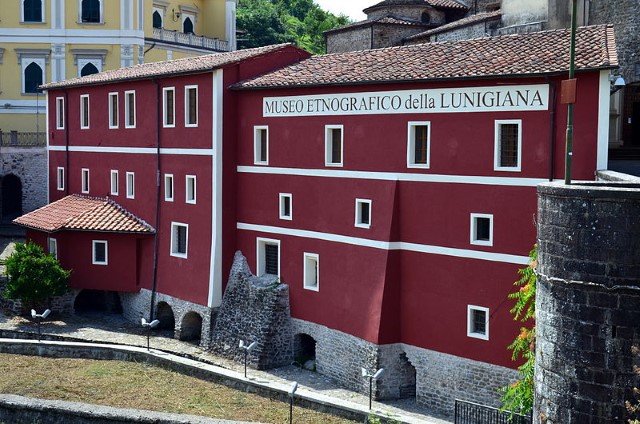
The main museums in the Lunigiana are:
- Il Museo Etnografico della Lunigiana, Villafranca
- Il Castello del Piagnaro, Pontremoli
- Il Museo dei Malaspina, Mullazo
- Il Museo dell’Emigrazione Gente di Toscana, Lusuolo
- Il Museo Audiovisivo della Resistenza, Fosdinovo
There are also several smaller museums such as Il Museo della Civilta’ Contadina Mario Nadotti at Lusignana which are opened only by appointment.
Table of Contents
Il Museo Etnografico della Lunigiana, Villafranca
Though nominally in Tuscany, the Lunigiana has more in common with Liguria and Emilia Romagna both linguistically and culturally — the valleys extend inland Northwards to Emilia Romagna, whilst the towns extend towards the sea and the Ligurian ports. (Carrara and Massa were also within the Ligurian sphere of influence until malaria was driven from the plains separating them from Pisa sometime during the last century).
The locals subsisted mostly through farming the valleys, growing hemp to make cloth and a variety of grains for bread. The woods provided chestnuts, and everything else was produced at home, from butter to butter churns.
The ethnographic museum, is located in an old mill that hugs the city walls. The first hall has scales, weights and measures used by merchants, folk medicine, votive offerings, breviaries, and other mementos of the religious life of the past, including a pleasingly naïf-style painting of Jesus and the Devil contending the soul of a dying man, who reluctantly resists temptation (women, games, money and music).
The next section, located in the top floor, is devoted to domestic life, with the troughs and tools the farmers used to process the chestnut crop, the spinning wheels and carding tools used to process hemp (the women spun it so finely it resembled linen), the looms they weaved the cloth with, and examples of traditional clothing, some made entirely at home and some with cloth bought from itinerant merchants. The patterned blocks used to die the finished cloth are especially interesting. Basket weaving was also an important activity, undertaken primarily by the men during the winters, when it was to cold or to wet to work the fields; there are examples of the baskets they wove for use in the fields and of those they made to sell at fairs. There are also cooking implements, butter churns and moulds, and all sorts of other things including fish traps. While one would expect a fish trap to be plain and functional (and it is), the amount of care taken in decorating the objects used in the home, even the simplest, is simply astonishing.
Descending a level there are exhibits devoted to the various trades. First the woodworkers, with a selection of their tools, and, much more interesting, the furniture the cabinet makers produced. There are tables, surprisingly elegant chairs and couches that bring to mind Windsor furniture, and a number of beautiful cradles, made from Faggio (a local wood) and dyed red with faggio sap to ward off the evil eye. They’re painstakingly carved with geometric patterns, especially stylized daisies. The next room is dedicated to stone carvers, who produced all sorts of things, from troughs to lintels. Again, the daisy is a common decorative motif, and you’ll receive a reminder of how frugal life was in the past from a stone capital which, being carved and shaped was valuable, and was therefore hollowed out to make a mortar when it was no longer needed at the top of a column. Smithing is next; most of what the smiths made was coarse, either shoes for horses and oxen or tools, but they did find time to make locks as well, and there’s a charming wrought-iron cradle that must have been some family’s happiest possession.
We descend another level, into a room with channels set into the floor that were used to direct the water to the mills until the 1950s. The room is now dedicated to the area’s wine-making traditions, with the shears used for pruning, baskets, and bottling equipment. The next room is dedicated to the tools used to process wheat, and then there’s the mill itself, with three millstones (for grain, corn and chestnuts) that were turned when the water struck the paddles of the wheels in the channels set under the floor. Milling was an abrasive task, and there are also the tools the miller used to dress his stones.
There’s also another hall, which likely served as a storeroom in the past and now houses temporary exhibitions. It’s a fun museum, ideal for children.
Address: via dei Mulini 71, 54028 Villafranca in Lunigiana. Tel: 0187 494400 (Biblioteca comunale); 0187 493417 (biglietteria Museo). Fax: 0187 493526.
Park by the town hall and cross the footbridge towards the mediaeval walls; the museum is at the end of the bridge.
Opening Hours: see web page.
Il Castello del Piagnaro, Pontremoli
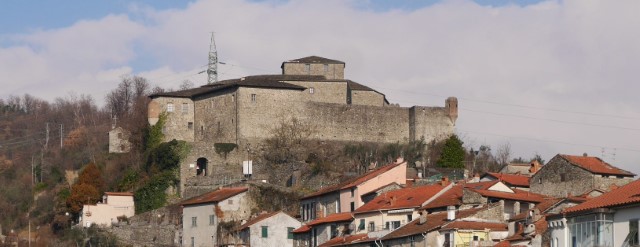
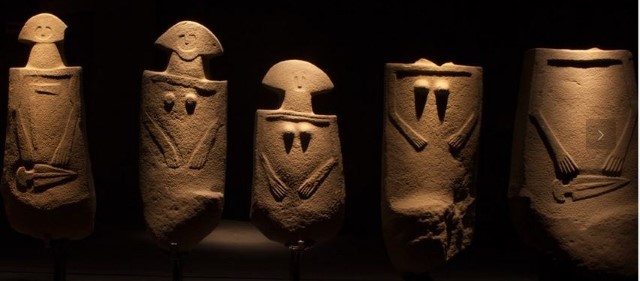
This Museum houses an excellent collection of ancient stone stele (lot more interesting than it sounds!). Full details (in English) may be found on the official web site available here.
The Museum is located in the Piagnaro Castle, Pontremoli. Its collection reveals an important phenomenon of megalithic europe. The Stele Statues, abstractly represented male and female human figures, were engraved in sandstone by peoples who lived between the IV and the I millenium BC. These prehistoric and protostoric images that feature heads shaped like a carabiniere’s hat and U-shaped faces are classified in three different groups (A,B,C) by archaeologists; they were made between the Copper and the Iron Age and have survived centuries; sometimes hidden, or used for purposes that have often changed their shape and function. Nowadays the Stele Statues are the signature feature of the Lunigiana, the Magra river valley where all the findings have been made. The Museum is the most comprehensive of its type in Italy with regard to the number of exhibits displayed and to the descriptions of the sites where the Stele were found, the materials used and the carving techniques employed.
Il Museo dei Malaspina, Mullazo
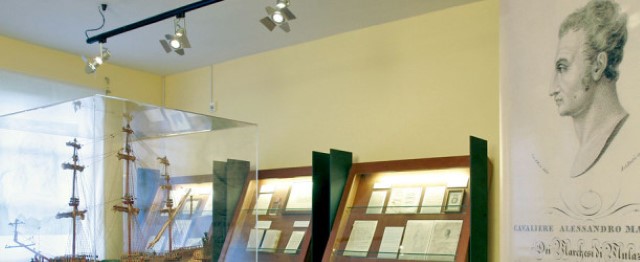
The top floor of the sixteenth-century palace that was the residence of the Marquises of Mulazzo now houses the Archive-Museum of the Malaspina, a Centre dedicated to the history of this family and, in particular, to the life and times of its most illustrious member: the navigator Alessandro Malaspina (1754 -1810), who led what is commonly regarded as the most important scientific expedition of the eighteenth century. The Centre preserves the domestic archive of the Malaspina di Mulazzo and offers a specialized library and an exhibition of interesting Malaspina relics.
Opening hours: see web page.
Il Museo dell’Emigrazione Gente di Toscana, Lusuolo
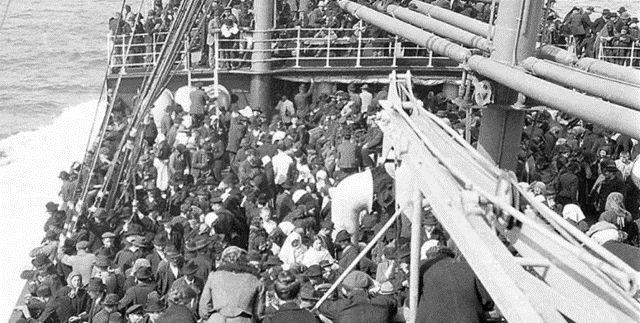
The Museum of Emigration of the People of Tuscany was born in 2004 from a collaboration between the Documentation Center of Emigration operating at the Comunità Montana della Lunigiana, the Region of Tuscany, the Council of Tuscans Abroad and the Municipality of Mulazzo with the goal of understanding and explaining the phenomenon of mass emigration from Tuscany that took place during the 19th and early 20th centuries.
It was designed and organized on two levels: one physical and the other virtual. In the first, housed within the walls of the Castello di Lusuolo, there is a library of books and documents, a media library, a conference room, and a space for viewing or listening to audiovisuals. There is also an exhibition that explains the reasons for emigration with particular emphasis on the personal testimonies of the individuals involved. These testimonies are enhanced by maps, letters, photographs and other documents which serve to bring the experience alive.
The virtual level was designed to be accessed through the museum’s web site where can be found the results of detailed research and scans of original documents made available to the museum by the families of those who emigrated.
Opening hours: see web page.
Il Museo Audiovisivo della Resistenza, Fosdinovo
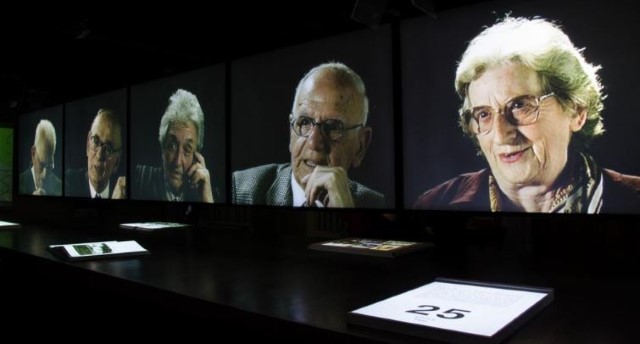
In 1948 a summertime mountain camp for boys and girls was created on land given by a private citizen to the Comune of Sarzana using voluntary labour provided by ex-partisans and local townsfolk. From that date until the summer of 1971 the camp provided summer holidays for thousands of children.
In the years that followed, the building fell into disrepair due to lack of adequate maintenance. During 1994, at the initiative of the ANPI (Associazione Nazionale Partigiani d’Italia) of Sarzana and with the support of the local Comune, it was decided to transform the building into a Museum of the Resistance of the Provinces of La Spezia and Massa Carrara; cities which had been decorated with the Gold Medal for Military Valour in recognition of the efforts made by their citizens to re-establish freedom and democracy in Italy.
In the fullness of time and with the assistance of numerous public bodies, associations and private citizens, the old camp was rescued and transformed into a monument for peace in a zone that had been a theatre of violent conflict between partisans, Germans and fascists and had endured both physical destruction and the senseless slaughter of many of its defenceless inhabitants.
Restoration of the building structure of the museum was completed in 1999 and the Museum was officially opened on 3rd June 2000. It contains modern audio-visual installations complete with multimedia support that allow people to journey through modern history and to deepen their knowledge both of the Resistance movement and of the development of Italian democracy.
The Museum is dedicated to the memory of the Partisan Commandant, Alessandro Brucellaria “Memo” and Flavio Bertone “Walter” and all those that fought for freedom.
The Museum is small. The main building is U-shaped, there being a kitchen/staff area in the left hand wing and public toilets/cloakrooms in the right hand wing. The central area is fitted out with tables on which the multimedia equipment is installed.
The Museum brings together the recollections and personal testimonies of individuals from different backgrounds who had diverse experiences of the hardships of war – country people, partisans, townsfolk etc. The emphasis is on war as it affects individuals and their local communities rather than on the wider historical context.
To get to Fosdinovo proceed by car as follows:
- via Autostrada A12 Genova-Livorno, taking the Sarzana or Carrara exit;
- via Autostrada A15 La Spezia-Parma, taking the S. Stefano or Sarzana exit; and
- via Strada Statale (SS) Roads 1 (Aurelia), 62 (Cisa Pass) and 63 (Cerreto Pass).
The SS 1 Aurelia junction for Fosdinovo is about 3km South of Sarzana in the locality of Ponte Isolone-Caniparola. From here the village is an 8km uphill drive away.
To reach Fosdinovo via the SS 63 from Cerreto, turn South on SS 446 at the Soliera junction and head towards Ceserano, S Terenzo & Tendola.
To reach Fosdinovo from Carrara proceed along the SS 446 in the direction of Gragnana, Castelpoggio and Monte Bastione.
To get from Fosdinovo to the Museum
The Museum is about 2km away from the village of Fosdinovo in the locality of Le Prade. Leaving Fosdinovo behind you, head North for about 1km on the SS446 in the direction of Tendola-Fivizzano, then at the “Foce del Cucco” fork, turn left towards Ponzanello and Canepari. After several hundred metres you will see the Museum in an slightly elevated position on the corner to your right. It is a colonial style building reached via steps. There is no car park, but roadside parking is available a couple of hundred metres further along the Ponzanello road.
Opening hours: see web page.
Casa Nardi Visitor Centre, Apella
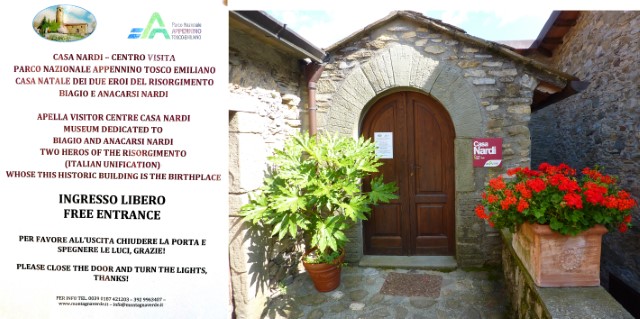
This historic building was the birthplace of two heroes of the Risorgimento (Italian unification), Biagio and Anacarsi Nardi, and was completely abandoned after WWII. In the early 1980’s it was donated to the local Council of Licciana Nardi by the Rotary Club of Carrara and Massa.
In the 2000s the National Park working in conjunction with the local council decided to fund renovation of the structure, and on completion of the work put it to use as a museum and visitor centre.
The museum is dedicated to the Nardis and contains information on the Lunigiana, traditional rural life, the National Park, and the villages of Tavernelle, Taponecco and Apella. There are also meeting and relaxation rooms, and civil wedding ceremonies may be carried out there. It is unmanned and open throughout the day. Management of the facility is undertaken by the Montagna Verde Agriturismo.
Directions to the museum may be found here.